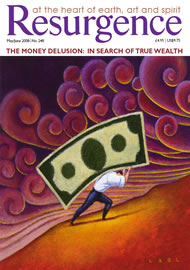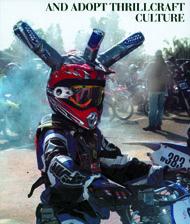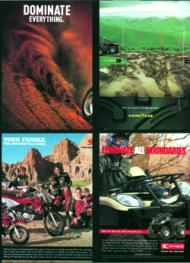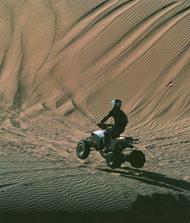AMERICA THE BEAUTIFUL’ is being trashed by careless people on motorised toys. All-terrain vehicles, jet-skis, swamp buggies, oversized four-wheel-drive trucks, and other destructive machines – hereafter collectively called thrillcraft – foster a pathologically individualistic attitude that revs up the adolescent male in every user, regardless of age or gender. Accommodated by our tolerant society, a ‘yahoo culture’ has sprung up around these thrillcraft, which in turn has provoked a devastating assault on the integrity, beauty and health of our public lands. This unpatriotic behaviour must be exposed – and ended. At risk is the natural heritage we are entrusted to pass along to future generations. Everyone who values clean air and water, healthy wildlife populations and the opportunity to find some peace and quiet while enjoying public lands has a stake in this fight.
This book is not about eco-religious convictions or highbrow aesthetics. Its focus is straightforward – to document the pervasive destruction of America’s public lands by a homegrown crop of eco-terrorists: people who wantonly disfigure landscapes in the pursuit of thoughtless, gas-guzzling “fun”. Shocking as some of these images are, the reality is far worse. Imagine an acrid smell, and see the lingering blue haze hang in the air as a horde of snowmobiles destroys the winter serenity of Yellowstone National Park. Feel the damage underfoot, the earth torn asunder in the Adirondack State Park, the forest floor now an eroding mud-pit where all-terrain vehicles have punched illegal tracks through the wilderness. Hear the buzzing whine of jet-skis, like a cloud of mutant mosquitoes from a bad science-fiction movie, as they churn the waters of Gulf Islands National Seashore, harass wildlife, and diminish others’ enjoyment of Nature’s beauty.
These are merely the most visible and direct environmental impacts of thrillcraft. Add to these the larger systemic effects of their manufacture, marketing and use, the consumption of finite fossil fuels and cumulative pollution as millions of internal combustion engines spew noxious fumes into the air, and one begins to gain a sense of the magnitude of the problem. Many conservationists and public land managers now recognise thrillcraft as a leading threat to the land’s ecological integrity.
This book seeks to alert everyone to this crisis of motorised ‘wreck-
reation’. Some will suggest that the best way to lessen the impact of thrillcraft is through rider education, peer pressure and expanded legal trail networks and access. This path, however, leads to even more destruction of wildlife habitat, contamination of air and water, and lost opportunities for solitude and quiet recreation as sanctioned trails become magnets for riders, who inevitably carve new renegade routes into wild country. Recreational thrillcraft use is fundamentally destructive. Mitigation or modest reform of an abusive activity is not an adequate response. Just as any civilised society worthy of the name would not countenance a little terrorism, slavery, paedophilia or torture, we should not tolerate the motorised assault on our public lands. Some behaviours are simply wrong.
Personal liberty is a bedrock American value. But our individual rights are not limitless. We have no right to chop down trees in a public park, even if logging were our preferred form of recreation. We have no right to ride a dirt bike across the lawn at the Washington Monument, even though it is a public space. Nor is it socially acceptable or legal, in most places, to blow one’s cigarette smoke into the air of a workplace or restaurant, even though smoking in one’s home is a legal activity. Until the day when recreational pollution becomes unthinkable (or the petrol pump runs dry), thrillcraft users should be obliged to enjoy their hobby only on private property where they have permission to ride their machines.
Our behaviours are limited by consensus and cultural values, and it is time to recognise that individuals – who otherwise may be productive citizens and nice people – have no right to pursue personal gratification in a way that harms public lands. Thrillcraft users display a blatant disregard for a value most Americans hold dear: that public lands are a scarce reservoir of wildness in a rapidly urbanising world; a place for wild creatures to find sanctuary and for people to reconnect with Nature. Contrary to the assertion made by some thrillcraft users that banning them from public lands is a form of elitism, it is in fact their behaviour – which diminishes the experiences of others while elevating the thrillcraft user’s individual enjoyment over all other values (including the health of the land community) – that is elitist.
THIS UNACCEPTABLE BEHAVIOUR is ‘slob recreation’. There is no need to tiptoe politely around the issue, or soften the language. Moreover, the thrillcraft onslaught that is degrading the ecology of our public lands is accelerating. Reams of scientific evidence document the negative effects, and a quick glance through this book reveals environmental damage from sea to shining sea. At a time of energy shortages and uncertain supplies, one can easily make a case that slob recreation of the motorised kind is frivolous at best, if not downright unconscionable.
We have laws that forbid speeding, beating animals, disturbing the peace, smoking on aircraft, littering, trespassing, emitting pollutants of various kinds, camping and hiking in unauthorised places, and so on. It should not seem so radical, therefore, to suggest that vehicular abuse of natural landscapes should be subject to increased regulation or prohibition. Just as our laws have evolved to protect pedestrians and nonsmokers from the excesses of careless individuals, they now need to protect the safety and health of our public lands from careless individuals and their motorised toys.
Could the founders of our National Park System, National Wilderness Preservation System, National Wildlife Refuge System and other public lands have ever imagined mechanical conveyances that could go virtually anywhere? Who would have thought the day would come when traditional back-country pursuits such as hiking, bird-watching and canoeing would increasingly be displaced by thrillcraft? That day has arrived, and responsible, quiet users of public lands are now suffering a diminished Nature experience because of noisy machines that physically damage the vegetation, soils and water of those lands.
Surely a dialogue about what constitutes appropriate, respectful recreation and what constitutes slob recreation is a perfect forum for teaching family values? Concern for the entire biotic community, good camping ethics, cleanliness, quiet, neighbourliness and respect for others on public lands – these are true family values.
If someone paints graffiti on the Vietnam Veterans Memorial or the Washington Monument, we are outraged by this vandalism. If the same person chooses to defile another national landmark by racing a snowmobile through Yellowstone National Park, this behaviour is sanctioned by politicians and celebrated by
local merchants as contributing to the economy. Legal or not, this behaviour is a form of vandalism: an act that robs others of their right to clean air and quiet, and diminishes the wild world, home ground rather than visitor centre to other members of the land community.
Take it as a challenge to read this book, to look carefully at the damage being done to your land. Become enraged, and engaged. Ultimately, only citizen action can counter the elitist minority that wants to use the commons as outdoor ‘abusement’ parks. Will we fight for the freedom of wild places to stay wild, or allow the damage to continue?
This is an edited extract from the Foreword to Thrillcraft: The Environmental Consequences of Motorized Recreation, edited by George Wuerthner and published by the Foundation for Deep Ecology.
Thrillcraft is availble at: www.chelseagreen.com/2007/items/thrillcraft










